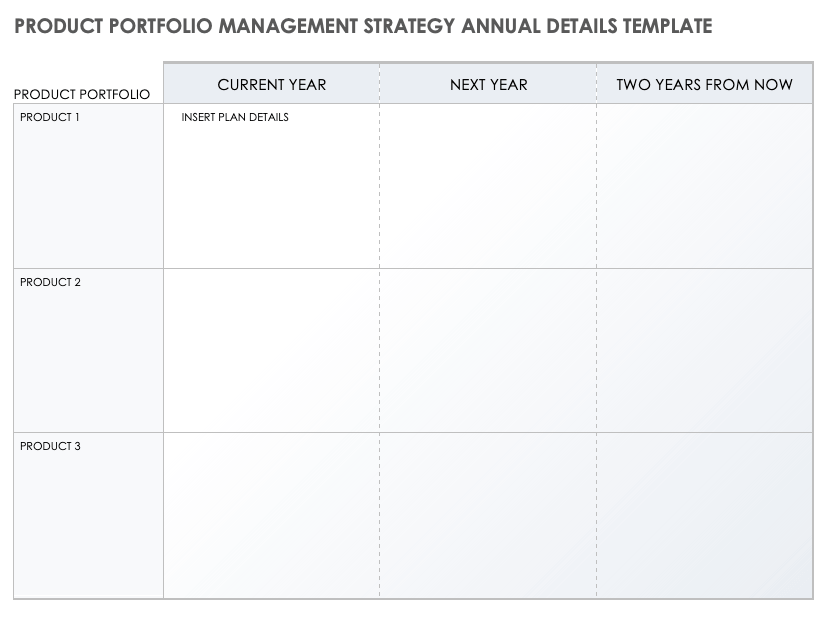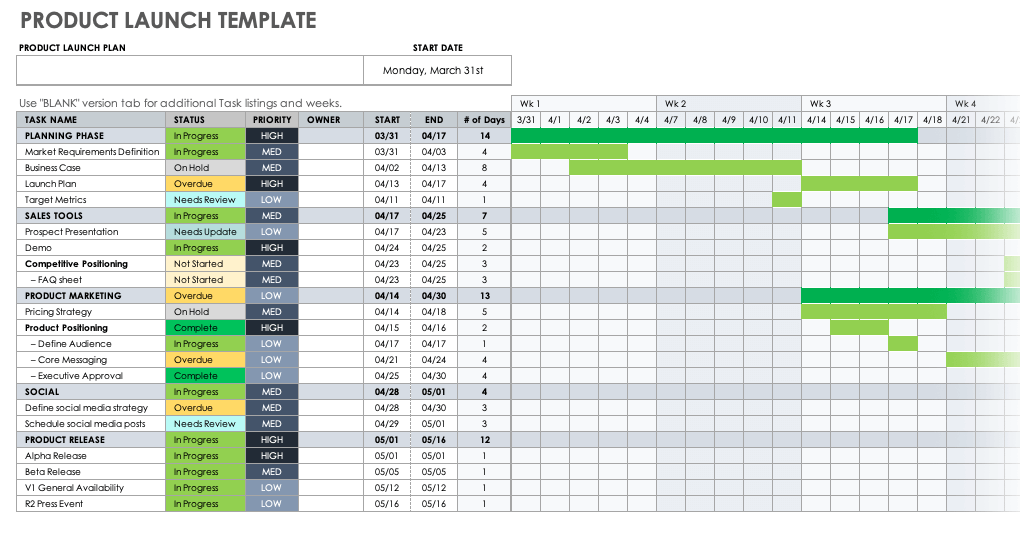What Is a Product Portfolio Strategy?
The term product portfolio strategy refers to a company's plan of action for aligning its products with its goals.
While the word "product" often refers to a specific physical product, in the context of this article, the term refers to features and service offerings as well as physical products. In other words, anything your company sells to clients is a product.
To put this concept into practice, let’s look at the following example of a product portfolio strategy.
Let’s say a CRM company is looking to increase the number of nonprofit customers using its product. The company has developed a new feature that manages fundraising and donations; this feature will most certainly attract new nonprofit customers. However, the organization has also created a new reporting feature that may benefit all of its customers. In order to determine which feature to develop, the company can use a product portfolio strategy. This strategy will allow the team to calculate risk-reward ratios, return on investment (ROI), and other key data that are essential to making the right decisions.
The Advantages of a Product Portfolio Strategy
Companies that apply a product portfolio strategy get closer to achieving their goals. A solid product portfolio management strategy ensures that resources that go toward the development of each product or feature are proportional to its priority. Additionally, the strategy determines which products help further the company's overall goals. When products and business objectives align, companies see a much higher success rate because they have a clearly defined plan that makes business sense. With this alignment, products are more likely to result in increased revenue and profitability opportunities.
In addition to ensuring alignment, the product portfolio strategy requires that the team takes a big-picture view of how a new offering fits within both existing offerings and market needs. With this strategy oversight, a company can minimize the risk of product failure by analyzing all elements associated with the entire product portfolio.
What Happens Without a Product Portfolio Strategy?
An organization's product portfolio strategy ensures that the company has the right mix of products. Without a product portfolio strategy, the company may end up giving resources to products and features based on who is "loudest" or has the most "clout," rather than on what supports the company's short and long-term goals. When this happens, revenue often decreases because the company is focusing on areas that may not help grow the company, and there's no time or money left to spend on the products that would actually drive revenue.
What Is the Role of Product Portfolio Strategy in an Organization?
Product strategy and product portfolio management are directly related, as the portfolio contains information that helps drive strategy. For example, if revenue is low for a specific audience segment, management starts with the portfolio to determine which products and features fit that audience. They then use the product portfolio information to ensure they have the right mix of products, not only to meet the needs of their audience, but also to meet the needs, resources, and objectives of the company.
How to Develop a Product Portfolio Strategy
Developing a product portfolio strategy is unique to each organization and involves understanding business goals, analyzing and understanding the product portfolio, developing product roadmaps, and measuring success.
Here are six fundamental tenets to help you build a product portfolio strategy:
- Understand Your Strategic Business Goals: You cannot create an effective product portfolio strategy without having a defined set of business goals that every member of the team fully understands. By reviewing the business goals together and involving leadership when needed, the team lays the foundation to build the product portfolio strategy. If any objectives are unclear, incomplete, or outdated, the team must have the appropriate leaders revisit and refine the goals before moving forward. Otherwise, the product portfolio strategy is based on ambiguous information.
- Develop a Set of Portfolio Evaluation Criteria: Using the strategic business goals, establish a set of key performance indicators (KPIs) that you will measure all products against. “This is the key. For example, if gaining market share in a new market is critical for your company, then that market share should be one of your KPIs,” observes Snyder. “Which of your products can do the most to gain that market share? Next, you need to establish weighting criteria for each KPI, so that you know what really matters most – is revenue more important than market share, or the other way around? Once you have three to six KPIs, and the weighting factors for each add up to 100%, you’re ready for the next step.”
- Develop a Product Portfolio Matrix: To ensure consistent decision-making and alignment, the team should create a product portfolio matrix that applies the evaluation criteria to each product. A matrix provides visibility into the performance of all products in your portfolio. For more details on product portfolio matrices and templates, read “Achieve the Right Balance of New and Established Products: The Product Portfolio Matrix.”
- Perform a Product Portfolio Analysis: Use the matrix to understand each current product. While it may be tempting to skip this step, doing so helps you determine exactly where you are regarding goals and product alignment.
- Develop a Roadmap for Each Product: The product roadmap defines the current and future direction of each product and ensures all resources and features are moving toward the same goals.
“The development of a roadmap should always be market-driven. If you have a deliberate internal process, metrics, and goals to ensure the organization can execute on a product portfolio strategy but aren't spending time with customers [and] listening to and empathizing with their stories, your plan is at risk,” said Sam Elliott, Head of Product at SoleVenture, Inc. “The best-executed product strategies are led by teams who understand that nothing important happens in the office. They get out and get to know what their customers need from their products and build impactful roadmaps to solve pervasive problems that their existing and future customers are willing to pay for.”
While the roadmap lives within product strategy, it can also stand alone for budgeting and resource discussions. Use our guide to creating strong product roadmaps for each current product and any proposed future developments. When you need to consider how to prioritize all of the inputs to your product roadmap, check out this guide to product prioritization and its accompanying webinar. - Measure and Continuously Improve: Define regular intervals at which you will measure success and dig into failures. By using the pre-established KPIs, the team has unbiased measurements to learn from. However, remember to measure the right KPIs for your specific product and strategy. Measurements such as recurring revenue, customer retention rate, customer acquisition cost, and customer lifetime value are metrics that you can use to evaluate product success. "It is important to consider the methodology you use to develop new products along the path from MVP to mature product with demonstrable ROI, and how you determine which products make the cut and which ones get sent back to the drawing board," says Mark Hughey, Principal Consultant at Arcweb Technologies. "This involves developing a pipeline of new initiatives, establishing a consistent MVP process, setting clear metrics for success or failure, and regularly reevaluating 'successful' products — not to mention ensuring that the products coming to market align with larger strategic goals." “Having a consistent end-to-end product process makes it easier for everyone involved to make better decisions,” says Roger Snyder, Vice President of Marketing and Principal Consultant/Trainer at 280 Group. “On this foundation, you have to build a process to evaluate opportunities using clear criteria that make it easier to advance the right opportunities to meet your company’s strategic goals.”
Product Portfolio Management Strategy Template
This template illustrates the yearly strategy for each product within your portfolio. Include each product's name along with annual plan details for the next three years. The template provides a single view of the strategy for each product.
Download Product Portfolio Management Strategy Annual Details Template
Excel | Word | PDF | Smartsheet
Product Portfolio Launch Strategy Template
Because launching new products is a core component of product strategy, consider using a template to create a consistent launch strategy for each product within your portfolio. This launch template guides your product’s evolution from development to positioning, general availability, and promotions.
Download Product Portfolio Launch Strategy Template
Product Portfolio Expansion Strategy
In order to determine whether to expand your product portfolio, use a product portfolio matrix, such as the Boston Consulting Group's (BCG) matrix or the McKinsey matrix.
This type of matrix will help you assess the strengths of products currently in your portfolio. Star products, for example, bring in high profits and may offer the opportunity to expand into other markets. Cash cows, on the other hand, are not ideal for investment.
Product Portfolio Strategy Examples
In order to determine a product’s performance and, therefore, make strategic product decisions, begin by properly managing your product portfolio. Below are examples of product portfolio management strategies, both good and bad.
Whether a product is a top market performer, a newer offering that is only available to a limited number of customers, or a dinosaur with outdated technology, it is crucial that you constantly evaluate its performance. Doing so enables you to identify portfolio gaps, growth opportunities, and the right time to discontinue.
Consider the following product portfolio strategies:
- Large, Diverse Product Portfolio: Many companies develop extensive and diverse product portfolios. Companies pursue this strategy with a kind of numbers game in mind: The more products you create, acquire, and modify, the more sales you’ll generate.
The most common problem with this strategy is that companies often fail to discontinue outmoded products, because they fear the prospect of losing sales. Organizations also frequently maintain oversized product portfolios, wherein products compete with one another, customers and sales teams become confused, and customer support, development, and sourcing become complex and unmanageable.
By putting a clear product portfolio strategy in place with a matrix, a company can simplify and streamline its portfolio. Utilize a matrix (such as the BCG matrix noted above) and metrics that identify overlapping products and help you to determine the following: which products to keep; how to organize your goods and services according to distinct product lines; when to sell off low-margin products; and when to discontinue products. - Small, Expandable Product Portfolio: While growing a bloated portfolio can lead to value-destroying complexity, expanding an existing portfolio can generate great opportunities.
For example, Tim, a general contractor, begins with a single product in his portfolio, home construction. As he builds houses and partners with licensed real estate sales reps to sell the homes, he realizes that he can obtain a real estate license and manage the sales himself. As a result, he sees that by expanding into mortgage services (and, thus, making his company a one-stop-shop for construction, sales, and mortgages), he can align his product portfolio perfectly.
With clear business goals, Tim has a solid understanding of the needs of his customers, the areas in which opportunities for profits exist, and the areas in which losses are occuring. For these reasons, he can safely expand his company’s product portfolio with minimal risk.
The Role of Marketing in Product Portfolio Strategy
Marketing is a key contributor to the product portfolio strategy. Product marketers, in particular, ensure alignment among the product, marketing, and sales teams.
When you’re creating your product portfolio strategy, it is vital to understand the Five Ps of marketing:
- Product: Product includes capabilities, branding, service offerings, appearance, packaging, and warranties.
- Price: Set a price that is appropriate for your brand and the customers it serves. When pricing a product, you must consider the total cost, discounts, sales and incentives, and credit and payment options.
- Promotion: You engage in the following activities in order to promote your product: public relations, direct marketing, social media, event sponsorship, digital marketing, and advertising.
- Place: In order to sell your product, you need to place your product. In order to place your product well, determine how you’re going to get your product to your customers. How will you distribute it? What are the distribution logistics?
- People: Understanding the needs of your customers — and your staff’s ability to fulfill those needs — is integral to your product’s success.
Product Portfolio Pricing Strategy
Pricing is an indispensable element of the product portfolio strategy. To price your products accurately, consider the needs and financial abilities of your full range of buyers. For example, you may use a tiered pricing strategy, bundle pricing, or another approach.
"As we price products, we must keep in mind that value and price are two different things. The value will vary depending on the product or service and the situation," says Elisabeth Cullivan Thomas of Launch Product Marketing. "For example, a woman may purchase a large, luxury SUV because she believes it offers her family good value for the money. By the same token, she may purchase a second car — an entry-level vehicle — for her business commute. This example demonstrates that a buyer determines value based not only on the price, but also on the nature of the specific circumstances."
So, you may price your products according to various strategies: high to allow for lowering as the market changes; low to penetrate the market quickly; formulaically, based on your costs plus mark-up; or competitively. Whichever strategy you use, though, be sure to understand two key concepts: one, the value that your product or service offers your customers and two, the strategy behind the pricing of other products in your portfolio.
Five Marketing Contributions to Product Portfolio Strategy
Product portfolio managers often overlook the marketing team when it comes to product strategy. Don’t make this mistake. Marketers gain tremendous insight from market research, customer interactions, campaigns, advertisements, and events.
Below are five key ways that marketers contribute to product portfolio strategy:
- Understanding Competitors: Even if your product meets the needs of your customers and aligns with your larger business goals, make sure that it differs adequately from other products on the market. With their comprehensive knowledge of competitors, marketers can help you achieve those points of differentiation.
- Understanding Market Gaps: Because of their thorough knowledge of the competition, marketers can quickly identify current gaps and needs in the market. A successful product portfolio strategy provides value, benefits, and features that fill unmet needs in the market.
- The Ability to Define the Target Market: Each product in your portfolio must fulfill the needs of at least one segment of your target market. Marketers have the business intelligence to define these needs and devise the market solution.
- Expertise in Messaging and Positioning: Products require clear and appropriate messaging and market positioning. Marketers understand the market’s problems and can, therefore, develop messaging that resonates with your audience.
- Translating Market Understanding into Useful Product Feedback: The product strategy team must foster and maintain strong relationships with the marketing and product marketing staffers. Marketers gather highly valuable intelligence from win/loss analysis, market research, and customer feedback, all of which are central to developing roadmaps for future products.
How Branding Contributes to Product Portfolio Strategies
Understanding how your company brands its products is an important part of the product portfolio strategy, because the logo, colors, tone, message, and images that your products share create a memorable impression, which will distinguish your company from the competition. (For example, Apple’s numerous products sport the company’s distinct corporate branding.)
There are many different branding methods. For example, a branded family utilizes a corporate brand across all product lines. Nike is an excellent example of a company that brands its products with the same name. Another branding strategy, a family of brands, is common in companies with a diversified portfolio of products that span many product categories. Kraft Foods, for example, includes A1 Steak Sauce, Boca Burger, Capri Sun, and Kraft Macaroni and Cheese. With this approach, consumers may not know the parent company owns the sub-brand, but the sub-brands build relationships with the target buyer. The advantage of sub-branding is that the sub-brand can build relationships with its specific target buyer. This strategy also protects the parent brand, should a sub-brand fail or incur reputational damage.
In other companies, a hybrid branding approach makes the most sense. Coca-Cola is an example of a hybrid brand: Coca-Cola has a product line that is branded Coca-Cola, along with other product lines with unique brands, such as Sprite.
Keep in mind that creating a logo and a company name is not, in itself, a brand strategy. As you define that larger brand strategy, remember to consider the objectives of your company, your target customers, growth plans, and success criteria.
Additionally, it is not uncommon for a company to reevaluate its brand as the company grows and the markets evolve. Signs that it is time to rethink your brand strategy include internal or external confusion, an acquisition or a merger, a new product launch, or if you have yet to develop a brand strategy.
Drive Results on Your Product Portfolio Strategy with Work Management in Smartsheet
Empower your people to go above and beyond with a flexible platform designed to match the needs of your team — and adapt as those needs change.
The Smartsheet platform makes it easy to plan, capture, manage, and report on work from anywhere, helping your team be more effective and get more done. Report on key metrics and get real-time visibility into work as it happens with roll-up reports, dashboards, and automated workflows built to keep your team connected and informed.
When teams have clarity into the work getting done, there’s no telling how much more they can accomplish in the same amount of time. Try Smartsheet for free, today.





